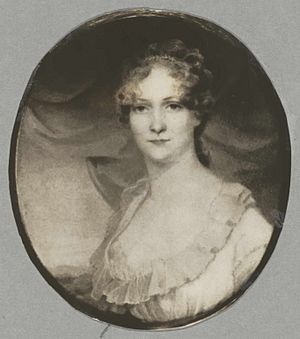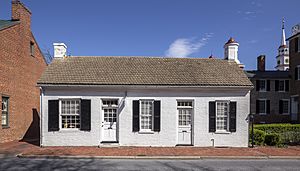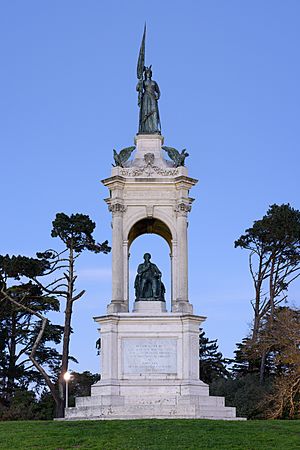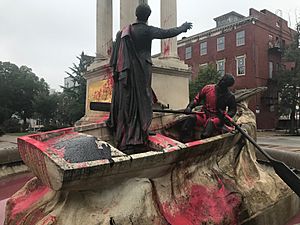Francis Scott Key facts for kids
Quick facts for kids
Francis Scott Key
|
|
|---|---|
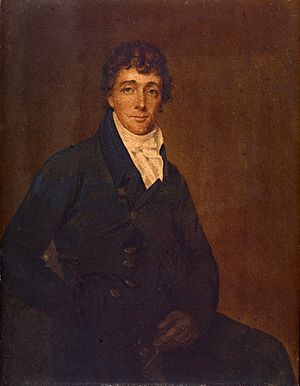
Key c. 1825
|
|
| 4th United States Attorney for the District of Columbia | |
| In office 1833–1841 |
|
| President | Andrew Jackson Martin Van Buren |
| Preceded by | Thomas Swann |
| Succeeded by | Philip Richard Fendall II |
| Personal details | |
| Born | August 1, 1779 Frederick County, Maryland (now Carroll County), US |
| Died | January 11, 1843 (aged 63) Baltimore, Maryland, US |
| Resting place | Mt. Olivet Cemetery |
| Spouse | Mary Tayloe Lloyd |
| Children | 11, including Philip |
| Relatives | Philip Barton Key (uncle) Francis Key Howard (grandson) F. Scott Fitzgerald (cousin) Roger B. Taney (brother-in-law) |
| Occupation |
|
Francis Scott Key (born August 1, 1779 – died January 11, 1843) was an American lawyer and poet. He is famous for writing the words to the United States national anthem, "The Star-Spangled Banner".
Key saw the British attack on Fort McHenry in 1814 during the War of 1812. He was so inspired when he saw the American flag still flying over the fort at dawn. This led him to write the poem "Defence of Fort M'Henry." It was published quickly with the music from a popular song called "To Anacreon in Heaven." The song with Key's words became known as "The Star-Spangled Banner." It slowly became popular as an unofficial anthem. More than a century later, President Herbert Hoover made it the official national anthem.
Key worked as a lawyer in Maryland and Washington D.C. for 40 years. He handled important cases and argued many times before the Supreme Court. He was chosen by President Andrew Jackson to be the District Attorney for the District of Columbia. He served in this role from 1833 to 1841. Key was also a very religious man and a member of the Episcopal Church.
Key owned slaves starting in 1800. People who wanted to end slavery often made fun of his words, saying America was more like the "Land of the Free and Home of the Oppressed." As District Attorney, he tried to stop abolitionists. He also helped lead the American Colonization Society. This group sent freed slaves to Africa. He freed some of his own slaves in the 1830s. He even paid one former slave to manage his farm and supervise other slaves. Key spoke out against slavery and sometimes gave free legal help to slaves seeking freedom. However, he also represented slave owners trying to get back runaway slaves. When he died, he owned eight slaves.
Contents
Francis Scott Key's Early Life
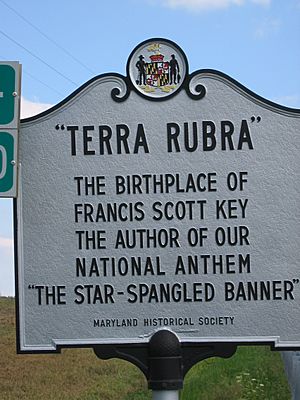
Francis Scott Key's father, John Ross Key, was a lawyer and a judge. His mother was Ann Phoebe Dagworthy Charlton.
Key grew up on his family's farm called Terra Rubra in Frederick County, Maryland. He finished college at St. John's College in Annapolis, Maryland, in 1796. He then studied law with his uncle, Philip Barton Key. On January 1, 1802, he married Mary Tayloe Lloyd.
How "The Star-Spangled Banner" Was Written
During the War of 1812, British forces burned Washington D.C. in August 1814. On September 7, 1814, Key and another American, Colonel John Stuart Skinner, had dinner on a British ship. They were there to ask for the release of Dr. William Beanes, an older friend of Key's. Dr. Beanes had been captured by the British.
After their meeting, Key, Skinner, and Dr. Beanes were allowed to return to their own ship. However, they could not leave the British fleet. This was because they now knew about the British plans to attack Baltimore. Key could only watch as the British attacked Fort McHenry for 25 hours. This happened during the Battle of Baltimore from September 13 to 14, 1814.
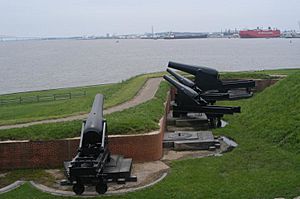
At dawn on September 14, Key saw a large American flag still waving over the fort. This sight deeply moved him. He began writing a poem about his experience on the back of a letter. On September 16, Key and his companions were released. That evening in Baltimore, Key finished his poem.
His poem was first printed as a flyer with no title or author. It was soon given the title "Defence of Fort M'Henry." It also suggested using the tune "Anacreon in Heaven," which was a popular song. Key had used this tune before for another song. The poem was quickly published in newspapers across the country and renamed "The Star-Spangled Banner."
Even though it was a bit hard to sing, the song became very popular. It competed with "Hail, Columbia" as the unofficial national anthem. This was especially true during the Mexican–American War and the American Civil War. More than a century after it was first published, the song finally became the official American national anthem. This happened in 1931 when President Herbert Hoover signed a law.
It is important to know that the third verse of "The Star-Spangled Banner" talks about Black people in a negative way. It shows Key's view of them trying to gain freedom by fighting with the British. The British had promised them freedom from American slavery.
Francis Scott Key's Legal Work
Key was a leading lawyer in Frederick, Maryland, and Washington, D.C., for many years. He handled many cases involving property and trials. Around 1805, he and his family moved to Georgetown, near the new capital city.
He helped his uncle, Philip Barton Key, in the famous trial of Aaron Burr. He also argued many times before the U.S. Supreme Court, starting in 1807. In 1808, he helped the President's lawyer in an important case.
In 1829, Key helped prosecute Tobias Watkins. Watkins was accused of misusing public money. Key also served as the lawyer for Sam Houston in 1832. After advising President Jackson for years, Key was nominated to be the District Attorney for the District of Columbia in 1833. He served until 1841. In 1835, he prosecuted Richard Lawrence for trying to assassinate President Jackson. This was the first attempt to kill an American president.
Francis Scott Key and Slavery
Key bought his first slave around 1800. By 1820, he owned six slaves. He freed seven of his slaves in the 1830s. When he died, he owned eight slaves. One of the slaves he freed continued to work for him for pay. This person was a foreman on his farm and supervised other slaves.
Key also represented slaves who were trying to gain their freedom. However, he also represented slave owners who wanted their runaway slaves returned. Key was one of the people in charge of John Randolph of Roanoke's will. This will freed Randolph's 400 slaves. Key worked for ten years to make sure the will was followed. He also helped provide the freed slaves with land to support themselves.
Key publicly criticized the harshness of slavery. A newspaper once said that he "often volunteered to defend the downtrodden sons and daughters of Africa." The editor also said that Key "convinced me that slavery was wrong—radically wrong."
Key was a founder and leader of the American Colonization Society (ACS). This group's main goal was to send free Black people to Africa. Many free Black people were born in the United States by this time. However, historians say that upper-class American society, like Key's, could not imagine a society with many races living together. Most abolitionists and free Black people did not support the ACS. But the group's work eventually led to the creation of Liberia in 1847.
Key's Death and Lasting Impact
Francis Scott Key died on January 11, 1843, at his daughter's home in Baltimore. He was 63 years old and died from a lung illness called pleurisy. He was first buried in Baltimore. But in 1866, his body was moved to his family plot in Frederick at Mount Olivet Cemetery.
In 1898, the Key Monument Association built a memorial. Key's remains and those of his wife, Mary Tayloe Lloyd, were placed inside the monument.
Key's home in Georgetown was taken down in 1947. This was done to build a highway.
Even though Key wrote poems throughout his life, often with religious themes, they were not collected and published until 14 years after he died. Two of his religious poems are used as Christian hymns: "Before the Lord We Bow" and "Lord, with Glowing Heart I'd Praise Thee."
Key was a distant cousin of the famous writer F. Scott Fitzgerald. Fitzgerald's full name was Francis Scott Key Fitzgerald. Key's descendants also include the scientist Thomas Hunt Morgan and the musician Dana Key.
Monuments and Memorials Honoring Francis Scott Key
- A Francis Scott Key Monument stands in Baltimore. In 2017, it was vandalized with the words "Racist Anthem" and red paint.
- Two bridges are named after him. The first is the Key Bridge between Rosslyn, Virginia, and Georgetown in Washington, D.C.
- The other bridge is the Francis Scott Key Bridge in Baltimore. It is part of the Baltimore Beltway and crosses the outer harbor. It is near where the British ships were anchored when they attacked Fort McHenry.
- St. John's College, Annapolis, where Key graduated, has an auditorium named in his honor.
- Francis Scott Key was added to the Songwriters Hall of Fame in 1970.
- He is buried at Mount Olivet Cemetery in Frederick.
- Francis Scott Key Hall at the University of Maryland, College Park is named after him.
- Francis Scott Key High School in Carroll County, Maryland, is named in his honor.
- Francis Scott Key Middle School in Houston, Texas, is also named after him.
- Several elementary schools are named Francis Scott Key Elementary School, including ones in California, Maryland, Virginia, and Washington, D.C. There is also a Francis Scott Key School in Philadelphia.
- The Francis Scott Key Mall in Frederick, Maryland, is named after him.
- The Frederick Keys minor league baseball team is named after Key.
- A World War II Liberty ship called SS Francis Scott Key was named in his honor.
- The U.S. Navy named a submarine after him, the USS Francis Scott Key (SSBN-657).
- A monument to Key was built in Golden Gate Park in San Francisco. It was created by sculptor William W. Story in Rome. Protesters toppled the statue on June 19, 2020. It has been replaced by 350 black steel sculptures. These sculptures honor the first 350 Africans kidnapped and forced onto a slave ship in 1619. The sculptor is Dana King.
Images for kids
See also
 In Spanish: Francis Scott Key para niños
In Spanish: Francis Scott Key para niños


